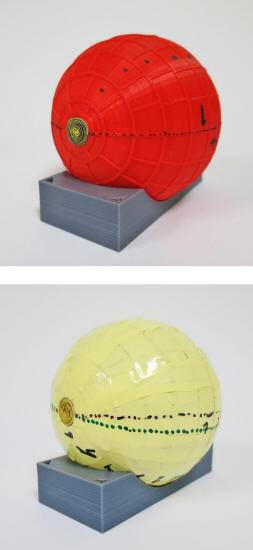|
from LiveScience Website
Here, a picture of
how the wormhole would work.
The idea of a wormhole comes from Albert Einstein's theories.
In 1935, Einstein and colleague Nathan Rosen realized that the general theory of relativity allowed for the existence of bridges that could link two different points in space-time.
Theoretically these Einstein-Rosen bridges, or wormholes, could allow something to tunnel instantly between great distances (though the tunnels in this theory are extremely tiny, so ordinarily wouldn't fit a space traveler).
So far, no one has found evidence that space-time wormholes actually exist.
The new wormhole isn't a space-time wormhole per se, but is instead a realization of a futuristic "invisibility cloak" first proposed in 2007 in the journal Physical Review Letters (Electromagnetic Wormholes and Virtual Magnetic Monopoles from Metamaterials).
This type of wormhole would hide electromagnetic waves from view from the outside.
The trouble was, to make the method work for light required materials that are extremely impractical and difficult to work with, Jordi Prat-Camps said.
Magnetic wormhole
But it turned out the materials to make a magnetic wormhole already exist and are much simpler to come by.
In particular, superconductors, which can carry high levels of current, or charged particles, expel magnetic field lines from their interiors, essentially bending or distorting these lines. This essentially allows the magnetic field to do something different from its surrounding 3D environment, which is the first step in concealing the disturbance in a magnetic field.
So the team designed a three-layer object, consisting of two concentric spheres with an interior spiral-cylinder. The interior layer essentially transmitted a magnetic field from one end to the other, while the other two layers acted to conceal the field's existence.
The inner cylinder was made of a ferromagnetic mu-metal. Ferromagnetic materials exhibit the strongest form of magnetism, while mu-metals are highly permeable and are often used for shielding electronic devices.
A thin shell made up of a high-temperature superconducting material called yttrium barium copper oxide lined the inner cylinder, bending the magnetic field that traveled through the interior.
A new device has created a magnetic wormhole, in which a magnetic field enters one end and seems to pop out of nowhere on the other side. Credit: Jordi Prat-Camps and Universitat Aut˛noma de Barcelona
The final shell was made of another mu-metal, but composed of 150 pieces cut and placed to perfectly cancel out the bending of the magnetic field by the superconducting shell.
The whole device was placed in a liquid-nitrogen bath (high-temperature superconductors require the low temperatures of liquid nitrogen to work).
Normally, magnetic field lines radiate out from a certain location and decay over time, but the presence of the magnetic field should be detectable from points all around it.
However, the new magnetic wormhole funnels the magnetic field from one side of the cylinder to another so that it is "invisible" while in transit, seeming to pop out of nowhere on the exit side of the tube, the researchers report today (Aug. 20) in the journal Scientific Reports (A Magnetic Wormhole).
Broader applications
There's no way to know if similar magnetic wormholes lurk in space, but the technology could have applications on Earth, Jordi Prat-Camps said.
For instance, magnetic resonance imaging (MRI) machines use a giant magnet and require people to be in a tightly enclosed central tube for diagnostic imaging.
But if a device could funnel a magnetic field from one spot to the other, it would be possible to take pictures of the body with the strong magnet placed far away, freeing people from the claustrophobic environment of an MRI machine, Prat said.
To do that, the researchers would need to modify the shape of their magnetic wormhole device.
A sphere is the simplest shape to model, but a cylindrical outer shell would be the most useful, Prat said.
|



